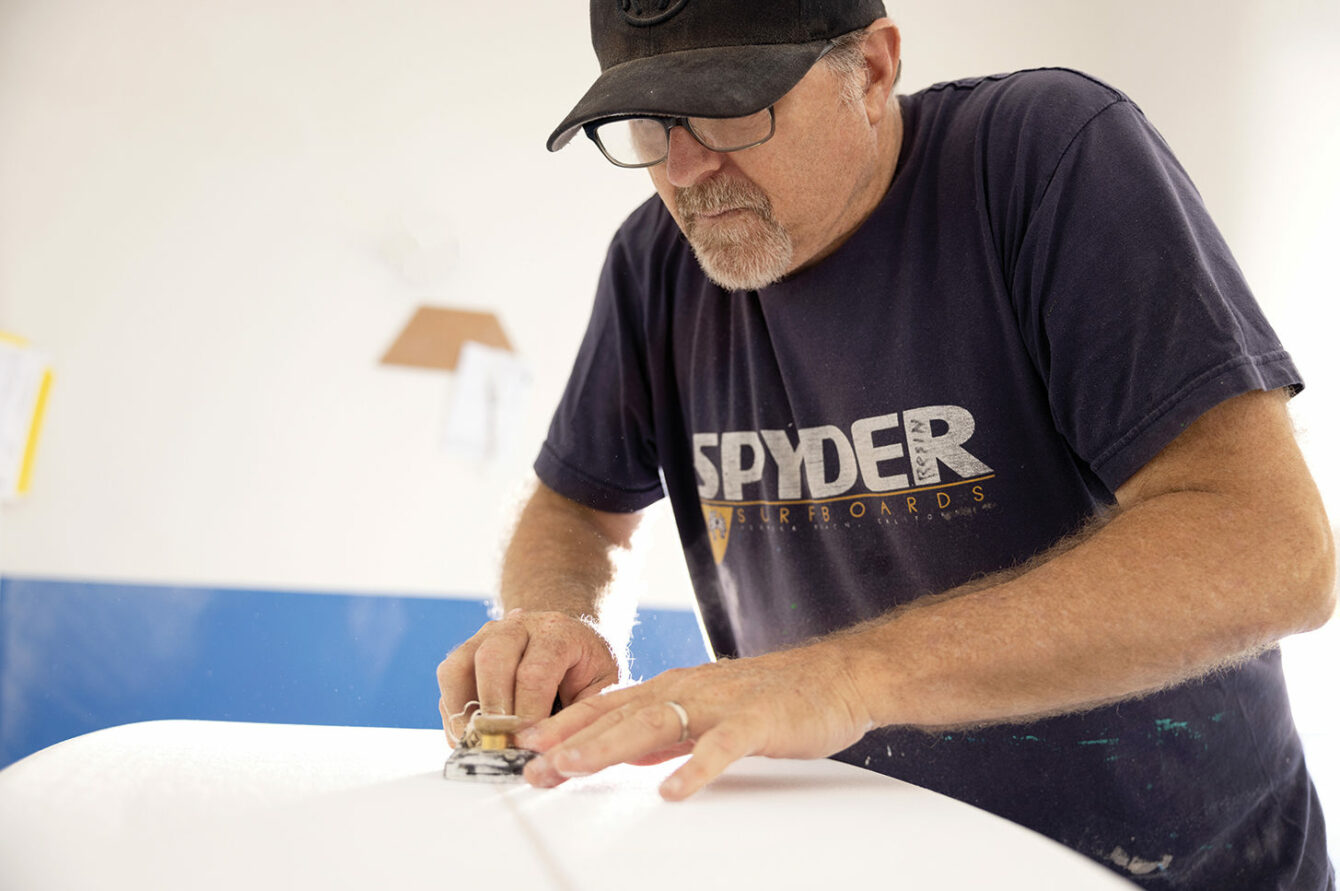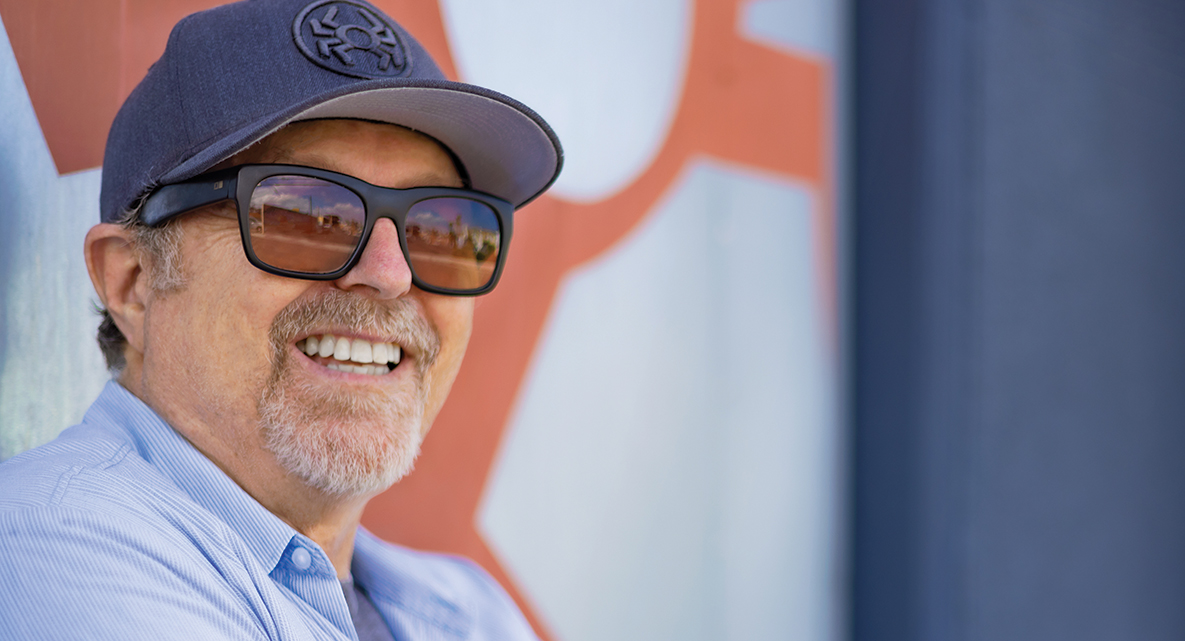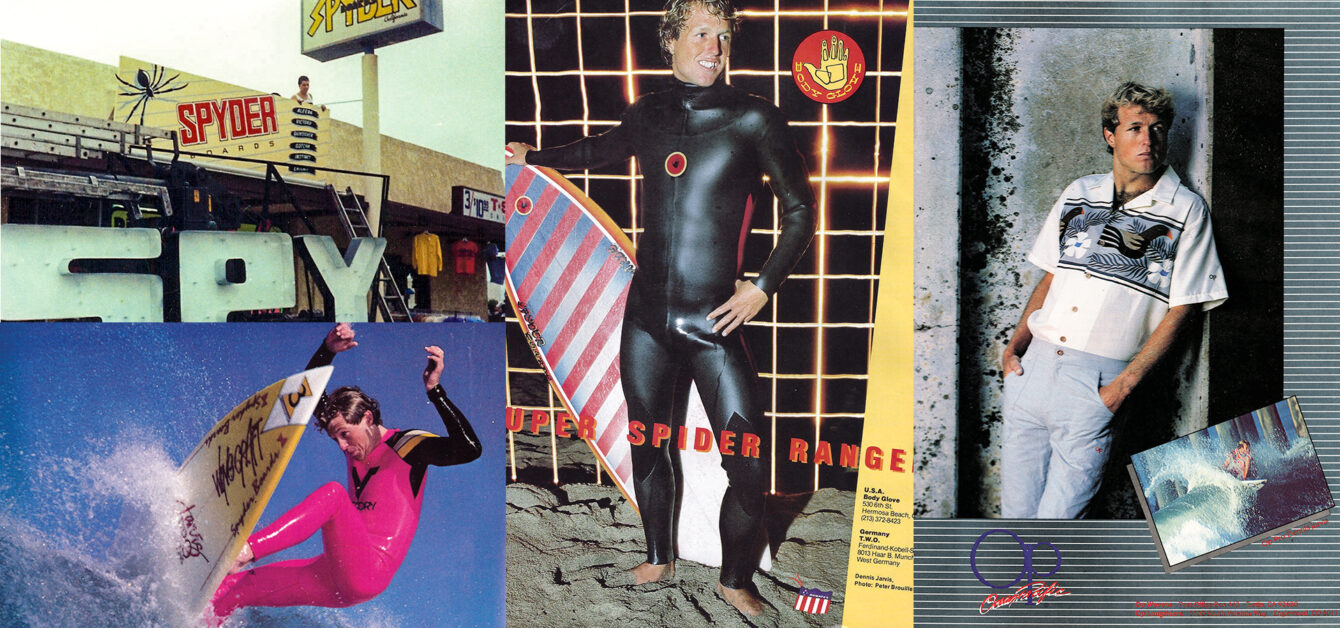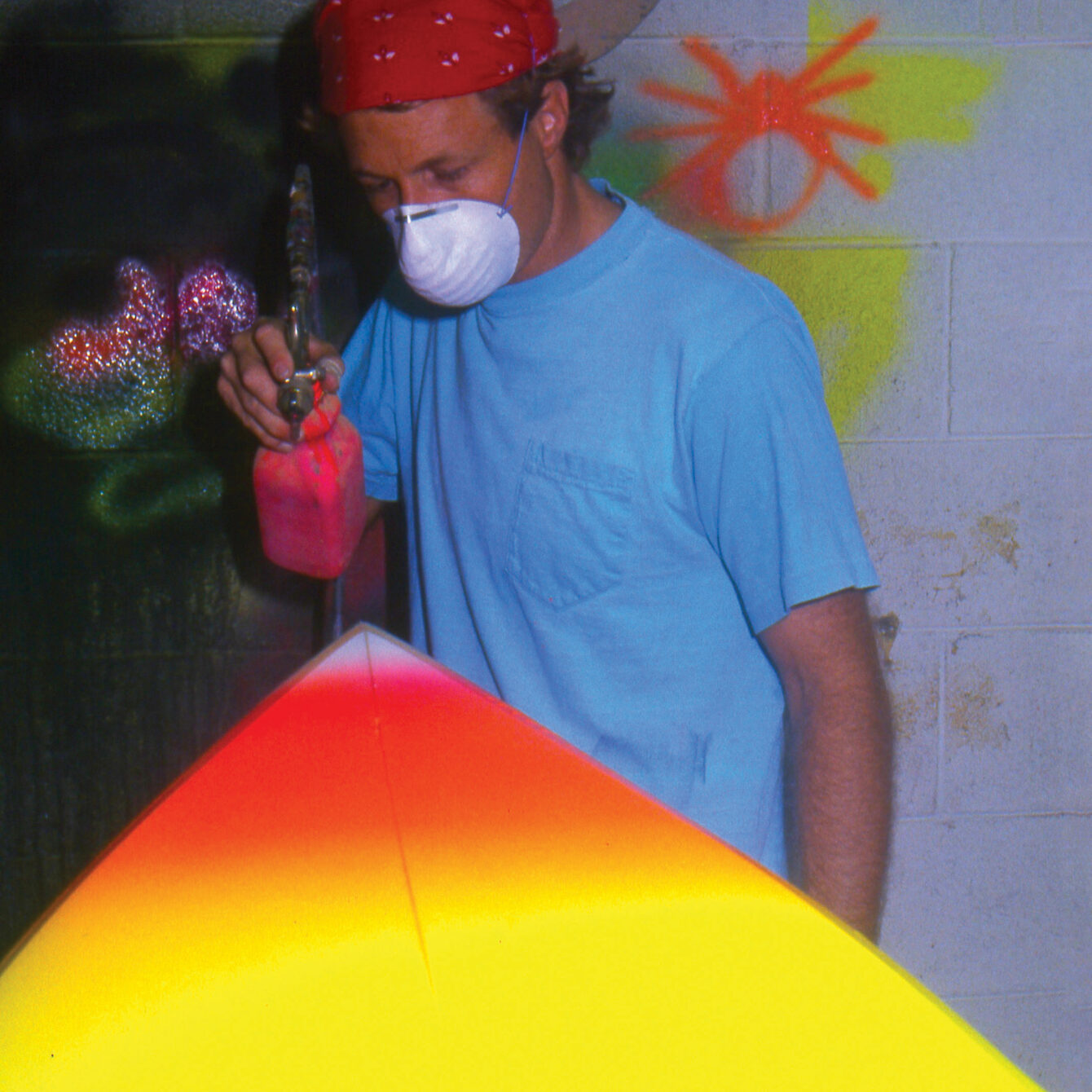About Us
 WE LIVE IT!
WE LIVE IT!
As one of the top young surfers on the International Professional Surfers competitive world tour in the late 1970s Dennis Jarvis needed a more high performance surfboard to take him to the next level. He had been working as an apprentice for several of the legendary surfboard builders while honing his surfing skills. He'd earned the nickname "Spyder" for the way he surfed with his arms bent that resembled the bend in a spiders legs. Dennis combined his acute shaping abilities with his surfing talent and in 1978 the Spyder Surfboard was born. Soon Dennis was traveling the world and competing on his own hand crafted designs and surfboard models - earning his reputation as one of the most refined and driven surfboard craftsmen in the world.
The demand for the Spyder Surfboard grew quickly. Having saved enough money from working tirelessly as a pro surfer and surfboard builder, in 1983 Dennis opened his first retail store - Spyder Boards - on the corner of Artesia Blvd and Pacific Coast Highway - just up the street from the small house in Hermosa Beach that he grew up in. Dennis could be found shaping surfboards in the back of the store while keeping an eye of the small retail offering of boardshorts, wetsuits and surf accessories in the front of the store.
Forty one years later Spyder Boards is still there in that same location. What was a small 800 sq. foot store amongst a cluster of small stores is now a 6000 sq. feet stand alone property full of the very best the surf, skate, snow industry has to offer. Including several hundred Spyder Surfboards that are still being custom crafted by Dennis Jarvis.
In 1997 Dennis opened Spyder Surf on Pier Ave to serve the newly developed Pier Plaza downtown Hermosa Beach. And in 2017 the Spyder Surf Manhattan Beach location was added.
The very best surfers in the world have ridden and continue to ride our Spyder Surfboards. In the late 1990's Spyder Surfboards were "the choice of the Momentum generation" and distributed throughout the best surf shops in the world. Dennis has been honored countless times for his contributions to the Surf Industry and his bronze plaque shines proudly on the Hermosa Beach Pier Surfers Walk of Fame. The stores have been designated "Surf Shop of the Year" nearly every year for the past 20 years or more. And Dennis continues to win Surfboard Shaper of the year.
We're one the very last "real" surf shops - still family owned, still building our own surfboards, still doing everything we can for our local communities, and still doing everything possible to get groms in the water and stoked on all the positive things that come from being a surfer!
“Simplicity is the key to a good design.” It’s a saying that Dennis Jarvis has lived by for more than 40 years. This quote has seen him through surfing professionally, creating a local surf empire with Spyder Surf and now working as an artist.

“It is stuck in my head,” Dennis says of the quote. “I hold that to everything I do. Sometimes I have the tendency to get too deep, so I need to back up.”
Talk to him for just a few minutes, and you can feel the energy he’s had his entire life. This drive helped him become so successful. He’s a Hermosa Beach local to the core—attending Mira Costa High School and learning to surf at 16th Street with a Hap Jacobs surfboard. He also surfed 30th Street with his brother and in the winter would be down at El Porto in Manhattan Beach.

Dennis knew early on that he was destined for a nontraditional job and life. Art got him through his adolescent and high school years, and he was airbrushing surfboards as early as middle school. He even painted Gene Simmons of KISS onto his surfboard and then did so for other friends who liked the way it looked.
It was through those kinds of activities that Spyder Surfboards was born. Dennis drew inspiration for the iconic logo after opening a MAD magazine in April 1977 and seeing a cool-looking spider crawling up the side of the page. He then started painting a similar spider on his and his friends’ boards. Given the technology in those days, he had to hand-design all the logos, which took a great deal of time.

After being on the cover of Surfer magazine in 1982, Dennis decided to open a shop the following year in Hermosa Beach right near the corner of Pacific Coast Highway and Gould Avenue. He realized he could use his magazine cover as a marketing tool, and he had saved enough money to open the store. Yet the beginning wasn’t exactly smooth sailing.
“I’d surf at the Manhattan Pier in the morning, take a shower and then go up to the shop—and no one was there,” says Dennis. “I’d listen to KLOS radio station with my hands on my face, with cars going by on PCH and no one at the store.”
It was then that Dennis realized how important customer service was if he wanted to keep his shop alive. In a time before cell phones, he knew that anytime someone called the shop, he somehow had to get them there in person.

His store inventory was as barebones as it gets in the beginning. Dennis carried surfboards he had shaped, about 100 pairs of OP board shorts—which he got from being on the OP surf team—as well as Spyder shirts and stickers.
“The first two years were probably the roughest times,” he says. “I still surfed, did competitions and was on magazine covers, but I didn’t travel. I couldn’t be away from the shop that long.”
He had unusual but successful marketing campaigns that got young, local surfers especially interested. One of those was Richard “Dickie” O’Reilly, who today is a managing partner at Spyder Surf. Dickie began hanging out at the shop when he was only 13.

“We’d have midnight pizza sales in the ’80s,” he remembers. “Every kid in Hermosa and Manhattan would come, and a line would be out the door. We’d do crazy business.”
Spyder managed to make it through, thanks to a boom in the summer of 1984 when skateboarding became big again and the store started carrying specific brands. Dennis also finally got a space next to the store where he could solely shape and airbrush surfboards.
During this time, most surfers wanted to be actors or models—and Dennis was no exception. His first movie was the 1986 film Short Circuit; he had one line. Dennis also acted in nearly 40 national commercials. While he fully admits that he was a terrible actor, his big break came with 1991’s Point Break starring Keanu Reeves and Patrick Swayze.
While he had no acting parts in the movie, he was brought on as a surf tech advisor. He taught all of the actors how to surf and also created all of the surfboards for the movie. Hermosa Beach played a big role in getting the actors ready. Dennis took them to 30th Street and taught them how to surf.
That experience didn’t just create more exposure for Spyder Surf. Dennis saw firsthand how Academy Award-winning director Kathryn Bigelow made important, calculated decisions. He knew he had to operate his business in the same way.
Throughout the 1990s Dennis attracted the top surfers in the world to ride his boards and even broke records with his brand, which has been featured on more covers of surf magazines than any other Los Angeles-based surfboard manufacturer since the 1960s. From 1994 to 1997 Spyder was one of the biggest surfboard brands in the world, selling close to 15,000 surfboards globally.

Those accomplishments took plenty of hard work. “The detail and craftsmanship with the boards are amazing,” says Dickie. “Dennis has had to fight to get credibility and respect. He’s had a chip on his shoulder about it in a good way. I think that is why he continues to work so hard.”
In 1997 Dennis decided to open a second Spyder Surf shop on the Hermosa Pier. While many weren’t sure that opening a second shop in the same city would be a good idea, Dennis and his partners knew better—especially since they grew up here. The store continues to be successful, and Spyder opened a Manhattan Beach store about six years ago.
Dennis was inducted into the Hermosa Beach Surfer’s Walk of Fame in 2015 and the Mira Costa Distinguished Alumni Hall of Fame in 2019. Given his ties to the community, he was especially honored to receive these awards. He founded the Spyder Surf Fest at Hermosa’s Pier Plaza, bringing together the surf industry’s most prominent brands and surfers.
“His name should be in bold on the Surfer’s Walk of Fame. What he means to surfing here in the South Bay is up there with the legends,” says Dickie. “He has always repped Hermosa, talking about how we are the real Surf City because of the history.”
An aspiring artist since he was young, Dennis’ passion has shifted recently from everything Spyder to creating one-of-a-kind pieces that can eventually allow him to create his own art show in the South Bay. “As far as how I draw my inspiration, I can honestly say I am inspired by those who are better than I am,” he says. “I look through books and walk galleries whenever possible, seeking inspiration.”
Dickie has always seen Dennis as an artist. “One of the first times I met him, he had a giant painting in his house that he had painted. I was blown away. It’s not too surprising that this is the path he’s currently on.”
Dennis is the first to admit that he is hard on himself. He’s finished pieces and then covered them up. However, he’s begun to be less critical and consider it all a learning experience.
As he continues to work on his art and play a big part in Spyder’s success and growth, one thing continues to be true: Dennis is willing to take chances and bet on himself. “I’m still an excited 16-year-old surfboard builder on the inside with aspirations to do challenging, fun stuff as I get older,” he says. “That’s why I am doing my art again. It keeps me sane and humbled.”
Walk of Fame: Dennis Jarvis Keeps Local Surf Culture Alive
Share on Email Share on Facebook
How a buck-toothed surf kid created a surf empire
Second of two parts
Spyder Surfboards mastermind Dennis Jarvis dedicated his life to surfing by the time he entered Mira Costa High School. He regularly began surfing the Hermosa Beach Pier after buying his first surfboard, a Jacobs’ “PanSea.”
“Lifeguard Billy Robinson, an amazing surfer, really got me into to surfing,” Jarvis said. “He’s the one who introduced me to Eddie Talbot and Mike Denoune.”
At Mira Costa, he would also be mentored by his art teacher, Mr. Jancar. Jarvis had a natural gift for art, and Mr. Jancar took notice.
“I was a “D’ student at best,” Jarvis said. “Mr. Jancar believed in me.”
Jarvis would spend more time on his work and wondered why other students that he was a better artist then were getting a better grade..
“I’d finish one painting while my classmates would finish five,” he said. “That’s when Mr. Jancar taught me the one thing that would become my marketing mantra, ‘Simplicity is the key to good design.”
Jarvis was beginning to be noticed in the surf world by the mid-1970s by competing in contests and traveling up and down the coast. He didn’t necessarily have a team to help him market himself, say like Mike Purpus’ “Hot Lips” team. Jarvis was more of a lone wolf.
“I’d make the trek down to surf Trestles,” he said. “After catching a pretty good set wave an older guy came up to me and gave me a compliment. That older guy was Jim Kempton, editor of Surfer magazine.”
Kempton invited Jarvis back to Surfer magazine’s office that day, where he met legendary lensman Jeff Divine.
“I always stopped by the Surfer magazine office on my way down south just to say hello,” he said. “It’s where I met and became friends with a lot of other pro surfers and leaders of the industry.”
In 1978, fellow South Bay pro Mike Benavidez invited Jarvis to South Africa with him to surf in a contest at the Bay of Plenty in Durban. On the trip, Jarvis had issues with the equipment he was riding.
“What I was riding from home didn’t translate to South Africa waves,” he said.“I went over to Safari Surf in Durban and exchanged my boards for materials and time in the bay and the glass shop. I lost my first heat but my board worked real well.”
In the late ’70s, Spyder Surfboard shaper/owner Dennis Jarvis crafted boards for the likes of Mark Cuff, Matt Warshaw, Mark Theodore, Allen Sarlo, and a young Chris Frohoff. He also began shaping for many of the top 16 in the world like Derek Hynd and Cheyne Horan.
“I was shaping boards for competing surfers, and I was surfing against them,” Jarvis said, laughing. “We were all friends.”
When Simon Anderson introduced the three fin thruster to the world in 1980, experimentation with multi fin set-ups hit mainstream surf consciousness.
“I was experimenting with twin fins, thrusters, and quad designs, surfing a lot of Newport,” Jarvis said.
Jarvis’ testing of surf design led to him inventing the first five fin set-up. (A honor Hurley International Founder and CEO, Bob Hurley, credits to Jarvis).
During the early ‘80s, Jarvis would make key relationships that would transcend perfectly into his life after a professional surfer/shaper.
“As a traveling pro, I befriended Bob [Hurley] who spoke at my Walk of Fame Speech, Paul Naude who is a sweet guy who was the CEO of Billabong and just launched Vissla,” he said. ”Being a solo guy, it was easy for me to click into the little surf scenes up and down the coast.”
After scoring a cover for Surfer in 1983, Jarvis pocketed his check and took it right to the bank.“I made $4,000 from that shot. I went to deposit it and realized I had $33,000 in my bank account,” he said. “I was going to go buy a Porsche or something but on the way home I saw the wig shop on the corner of Artesia Boulevard and PCH for lease — between an old t-shirt shop and a huge liquor store.”
Dressed in full surf styling. complemented with a layer of foam dust from shaping duties, Jarvis viewed the rental and was given the keys by the landlord. He went home that night to celebrate. During his celebration, he had a urge.
“I went back to the shop and started busting walls with a sledgehammer. After blasting one of the walls, there was a silver surfer [figurine] was inside one of the walls,” he said. “Needless to say, I had a couple months advance rent and the deposit the next morning.”
In 1983, Spyder Surfboards was launched. With the relationships he developed during his competition days, Jarvis got the top tiers of the surf industry on his shelves. By the mid to late 80s, with surf fashion becoming a mainstream fad, Jarvis with the help of managing partner Dickie O’Reilly would take Spyder to the landmark status.
“I have to thank Richard “Dickie” O’Reilly, my managing partner, for being instrumental in keeping Spyder on an even keel through the chaotic surf industry,” he said.
In the late 80s, Jarvis dabbled working as a part time actor. Besides working a few commercials, he worked as an extra and technical on Point Break and in the process befriended directors James Cameron and Kathryn Bigelow. Jarvis handled all the surf aspects including teaching the cast how to surf and hiring additional surf doubles like Matt Archibold, Vince Klyn, and Dino Andino.
“Patrick Swayze had a $500,000 clause that he’d surf in the movie for close-ups,” Jarvis said. “The wave Keanu Reeves catches at Leo Carillo, that’s his first wave standing-up ever.”
With his experience, he would go on to advise on other features. As for being in front of the camera, those days were done.
“I realized I was sort of a terrible actor,” Jarvis said. “ Since I am punctual and anal, my role is behind the scenes directing and producing.”
Jarvis realization also affected how ran Spyder. Jarvis stepped back from being the total image of the the brand. He then orchestrated one of the hottest surf teams of all time and brought Spyder to the forefront of the surf industry and surf culture.
By the early ’90s, Jarvis’s boards were seen frequently under the feet of the “Momentum Generation,” surfers inspired by Taylor Steele’s decade defining movie “Momentum.”
“I really have to thank Mike Balzer and Greg Browning,” Jarvis said. “Greg was a part of the whole Momentum generation while Balzer helped document it.”
With Browning being Jarvis’ roommate, a lot of pros ended up shacking up at the household.
“One night at the house, Donovan Frankenreiter spent the night and was like ‘Me and Gerr [Brad Gerhlach] are out [riding for Xanadu]’,” Jarvis said. “It all clicked and I had an opportunity that I couldn’t pass up.”
Jarvis would go on to shape boards for Tom Curran Conan Hayes, Benji Wheatherly, Ben Bourgeois, Sean Hayes, Luke Stedman, Layne Beachley, Keala Kennelly, and two youngsters Chris and Alex Gray. He designed with Tommy Peterson (Aussie Surf legend Micheal Peterson’s brother) the fireball fish, the surf design the resurrected the “fish” shape after Curran ripped on one in the Rip Curl surf movie series “The Search.”
“By 1994 to 1996, we were number three in the world, selling 15,000 surfboards worldwide,” Jarvis said, “I was the go-to shaper for the top 16 ASP pros during the US leg of the tour.”
With his success, Jarvis opened up Spyder II on the Pier Plaza at the same time he started Spyderbilt Clothing. With “15 ghost shapers,” the retail shop, and the Spyderbuilt, Jarvis was spending eight hours a day in Costa Mesa working the business aspect of the company and four hours a day in the surfboard factory in Gardena.
“In the factory, I’d be fixing 200 shapes at a time getting them to my standards — it was tedious,” he said. “I was dusty and crusty and decided to scale back.”
Part of scaling back for Jarvis meant increasing his efforts into giving back to the community that created him. He has sponsored the Mira Costa Surf Team since 1993, the South Bay Boardriders Club and running the South Bay Scholastic Surfing Association for the last two years (with his main man O’Reilly as the league director). For the last eight years, Spyder Surfboards has organized and sponsored the Spyder Surf Fest and LA Surf Awards.
“You’ve got to give back to get the stoke back,” he said. “What keeps my industry thriving is to stoke out that 12 to 14 year old grom. If not, I am out of business.”
After producing 75,000 surfboards, getting the most industry publicaion covers of any local surfboard manufacture since the1960s (three of which are Jarvis), influencing and directly helping countless groms get their start, and running a successful local surf mecca for 31 years and counting, Jarvis was elected to the Hermosa Beach Surfing Walk of Fame last Saturday.
“It is truly an honor to stand next to Chris, Mike and Derek as we are inducted in the Surfers Walk of Fame together. I am humbled to have my plaque alongside those who have come before me,” said Jarvis, “I can’t put into words how amazing it feels to be recognized by my hometown and the surf industry who have been really good to me and my family. Thirty years goes by fast when you get to do what you love for a living.”








